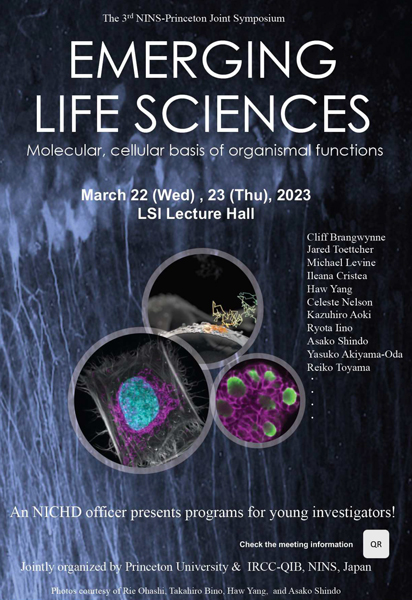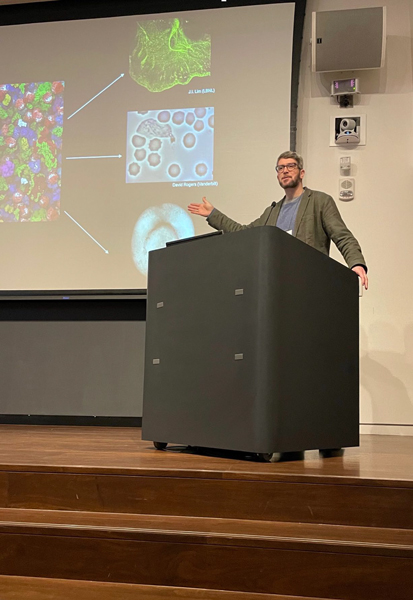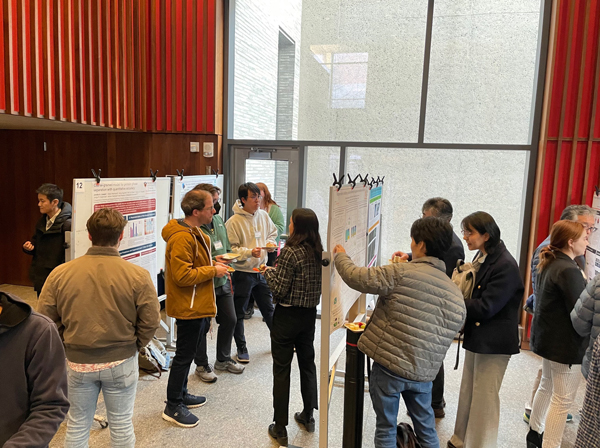Meeting Report: The third NINS-Princeton joint Symposium “Emerging Lifesciences”
Department of Quantitative and Imaging Biology (QIB), Headquarters for Co-Creation Strategy, NINS
Naoto Ueno
The joint symposium with Princeton University was held on 22 and 23 March 2023 at Princeton University, USA, based on an international collaboration agreement signed by the National Institutes of Natural Sciences in 2010. Both the first and second symposia were held in Okazaki, but this is the first joint symposium to be held at the University. As the title of the symposium suggests, the theme covered a wide range of cutting-edge topics in the life sciences, from chemistry, biophysics and bioengineering to cell and molecular biology (Fig. 1). The host, Prof Jared Toettcher (Dept. Mol. Biol.), was of great help in the preparation of the symposium. Eight speakers from Princeton University and seven from Japan, including NINS, gave lectures. In addition, as a special feature of the conference, Dr Reiko Toyama, Program Officer at the National Institutes of Health (NIH), USA, spoke about the NIH's support program for young researchers. Four young researchers from Japan also gave poster presentations, and the NIH provided travel support to three of them (see reports of the three below). Three of them, including two, were asked to give oral presentations. The quality of the presentations (Fig. 2) was high, and the 16 poster presentations were very lively (Fig. 3), which we believe helped to achieve the objective of the symposium, which was also to promote exchange between young researchers in Japan and the USA. On the next day after the symposium, Japanese researchers visited laboratories of their choice for observation and discussion. One of the outcomes of the symposium was the opportunity to communicate with postdocs and graduate students and to exchange information with them.
I would like to take this opportunity to thank the Liaison and International Affairs Section and the Financial Affairs Section for their hard work in preparing and executing the budget for this symposium, which was held at the end of the academic year, as well as Ms Ellen Brindle-Clark and Ms Mami Akiyama, assistants at Princeton University, for setting up the venue and the reception on the day of the symposium. I would also like to thank Ms Ellen Brindle-Clark and Ms Mami Akiyama, assistants at Princeton University, for their hard work in setting up the venue and for their help at the reception desk.

Fig1. Flyer for announcements

Fig2. Professor Cliff Brangwynne, the first speaker at the symposium

Fig3. Poster Presentation
National Institute for Basic Biology
Hiroshi Koyama, Assistant Professor
Attended The 3rd NINS-Princeton Joint Symposium. In addition to collecting information and presenting my own research, I visited two laboratories at Princeton University and exchanged information with their researchers.
In the meeting, Dr Nelson showed that the mechanical mechanism of lung morphogenesis, which is the interaction between epithelial cell sheets and smooth muscle tissue, differs between species. The importance of the interaction between the epithelial cell sheet and the smooth muscle layer was also evident in my research on the morphogenesis of the fallopian tube, which I recognized as a fundamental element in organogenesis. In the presentation of thyroid morphogenesis by Dr Shindo, there was a discussion on possible mechanical mechanisms of cavity formation in the tissue. Dr Levine and others presented their research on how enhancers can interact with promoters in the regulation of gene expression. Dr Levine and colleagues have raised the possibility that liquid-liquid phase separation could explain the question of why enhancers can interact with promoters in the regulation of gene expression. It was astonished by that recent work on liquid-liquid phase separation provided a clear clue to a major problem that has persisted for decades.
During a visit to Dr Nelson's laboratory, I was told that they are carrying out multicellular simulations using a particle model. I was aware that Dr Nelson herself had introduced about my research to her laboratory, and that my approach for estimating the interaction forces between particles was received with a certain amount of surprise. I believe that my estimation method would be applied to various tissues and organs.
During my visit to Dr Brangwynne's laboratory, I was introduced to research exploring biological phenomena involving liquid-liquid phase separation, and found that it occurs in more physiological contexts than I had realized. On the other hand, my question was a physical one: how can molecules such as proteins and RNA have droplet-like behavior as a result of condensation? The particle model is a framework that applies to cells, molecules and atoms, but it is not obvious that condensates of particles can have liquid-like behavior because they are easily jammed. If they are modelled as a polymer made up of a series of particles rather than as mere particles, they can reproduce liquid-like behavior.
The above-mentioned laboratory, which we visited, has a wide range of human resources in areas such as experiments, engineering such as macrofluidics, theory and mathematics, and is developing research that systematically links these areas. Such laboratories are probably few and far between in Japan, and I think it is necessary to have the power to gather human resources and the intelligence to link them together.
National Institute for Physiological Sciences
Toshikazu Miyata, Ph.D. student
By attending the NINS-Princeton Joint Symposium, I was exposed to a lot of cutting-edge research being conducted by both NINS and Princeton University. The symposium covered a wide range of important topics in the life sciences, including genomics, single molecule imaging, transcriptome analysis, mathematical modelling, cell dynamics, organogenesis and neurobiology. All the presentations were very interesting, informative and fruitful for future collaborations, such as joint research. The symposium was a lively discussion and provided a good opportunity for me to think about the content of the discussions, even though I do not have deep knowledge about the talks from outside my field. Also, there was a lively exchange of opinions among the students and researchers who participated in the symposium about the poster presentations, and the various comments and advice I received were a great motivation for me to continue my own research in the future. In addition, the opportunity to hear from Japanese students currently studying at Princeton University and to obtain information on the university environment and living conditions in Princeton also helped me to think about studying abroad.
During the laboratory visit after the symposium, I was able to visit the laboratory of Dr Jesse Gomez, who conducts research on human brain imaging using MRI, which is deeply related to my research theme, and was given a tour of the laboratory and participated in lab meetings. I was able to see the research environment at Princeton University. I was also able to interact with the lab members and get a feel for the atmosphere of the lab, which was very helpful when considering studying abroad in my future research career.
Being able to participate in a symposium like this not only allowed me to learn about a wide range of research fields and gain new knowledge about my own research, but it was also very helpful in considering my future career path as a scientist. I am grateful for this valuable opportunity and I would like to work hard in my future research activities.
Exploratory Research Center on Life and Living Systems (ExCELLS) and National Institute for Basic Biology
Yusuke Mii, Assistant Professor
I participated in the Joint Symposium entitled Emerging Life Sciences, which was organized by Dr Ueno, and it was my first visit to Princeton University. Princeton University is a university with a long history, and I learnt about its history during the campus tour given by Prof. Yibin Kang, who gave a seminar at the NIBB shortly before this symposium. I was surprised to learn that Princeton University was established before the establishment of the United States of America. We also had the opportunity to eat breakfast in the historical Hall as a campus cafeteria, which gave us a glimpse of campus life.
The symposium was an opportunity to concentrate on cutting-edge science, with topics ranging from developmental and molecular biology, which are close to my specialties, to biophysics and bioengineering. I was particularly impressed by Dr Michael Levine's talk on transcriptional regulation, including his presentation style. Dr Eric Wieschaus, a Nobel Prize winner, also joined in the discussions at times, which made me realize once again what a fantastic place for science this is. It was very meaningful to have the opportunity to interact with up-and-coming researchers from Japan, including Drs Fukaya and Sawai from the University of Tokyo, Dr Shindo from Kumamoto University, and Dr Akiyama from the Biohistory Research Hall. I was also given the opportunity to present my research on 'planar cell polarity', which I have been working on as a JST-PRESTO project. Dr Danelle Devenport, who is conducting excellent research on planar cell polarity at Princeton University, was there, and it was a great occasion for me to be able to visit her lab, introduce my research to her and have a discussion with her. Science is also a human activity, so human connections are very important, and I am very grateful to have been given this opportunity to interact with many people at this symposium.







